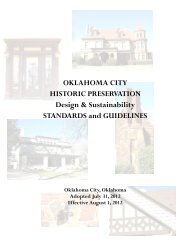OKC Plan, 2000-2020 - City of Oklahoma City
OKC Plan, 2000-2020 - City of Oklahoma City
OKC Plan, 2000-2020 - City of Oklahoma City
Create successful ePaper yourself
Turn your PDF publications into a flip-book with our unique Google optimized e-Paper software.
Rural Neighborhoods<br />
Rural areas are primarily used for agricultural, forestry, mining purposes and scattered<br />
residential development. Rural areas for the purposes <strong>of</strong> the plan are areas that do not require a full<br />
range <strong>of</strong> essential city services. Essential services are defined in the 1990 <strong>OKC</strong> <strong>Plan</strong> as Water,<br />
Waste Water, and urban fire protection. For the purposes <strong>of</strong> this discussion, “rural” will be defined<br />
as all areas <strong>of</strong> <strong>Oklahoma</strong> <strong>City</strong> that presently lack one or more essential service and where such<br />
services are not anticipated to be made available for at least 20 years. Areas in which it is anticipated<br />
that all essential services are to be made available during the <strong>Plan</strong>ning period will be defined as<br />
Growth areas, even if the present character is Rural.<br />
Assets<br />
Because <strong>of</strong> the large incorporated area and its location between the woodlands to the east and the<br />
rolling prairie to the west, <strong>Oklahoma</strong> <strong>City</strong> has a wide variety <strong>of</strong> rural areas. These areas include the<br />
wooded areas to the east and northeast, the rolling and partially wooded countryside east <strong>of</strong> Draper<br />
Lake, the scenic areas south <strong>of</strong> Mustang, and gentle prairie topography in the north and northwestern<br />
parts <strong>of</strong> the city. All these areas provide a rich and scenic context for the urban area and contain a<br />
variety <strong>of</strong> assets that are in critical need <strong>of</strong> protection. These assets include the following:.<br />
The agricultural, ranching and oil and gas extraction uses contribute significantly to the<br />
<strong>Oklahoma</strong> <strong>City</strong> economy.<br />
Rural areas provide locations for people who choose to live close to the city but enjoy the peace<br />
and quiet <strong>of</strong> the countryside.<br />
The surrounding rural areas provide a scenic context for the city. Properly protected, the<br />
surrounding rural areas can pleasantly contrast with the intense development <strong>of</strong> the city and be a<br />
source <strong>of</strong> community enjoyment and pride.<br />
Many <strong>of</strong> the rural areas are in the watershed areas <strong>of</strong> <strong>Oklahoma</strong> <strong>City</strong>’s lakes (and surrounding<br />
lakes, such as Thunderbird and Arcadia) that provide storage for the region's water supply.<br />
Protection <strong>of</strong> these areas was a reason for the aggressive annexation program <strong>of</strong> the 1960's.<br />
The rural areas include recharge areas for the region's aquifers, such as Garber-Wellington.<br />
Directions<br />
The historic uses, such as agricultural, ranching, and oil and gas extraction (where they are not<br />
detrimental to the environment or neighboring properties), should be encouraged to continue and<br />
be supported by appropriate services in rural areas.<br />
Natural assets, such as wooded areas, natural topography, wildlife habitat, creeks and wetlands<br />
should be protected.<br />
An appropriate level <strong>of</strong> rural public services should be provided in an efficient and economical<br />
manner.<br />
1

















